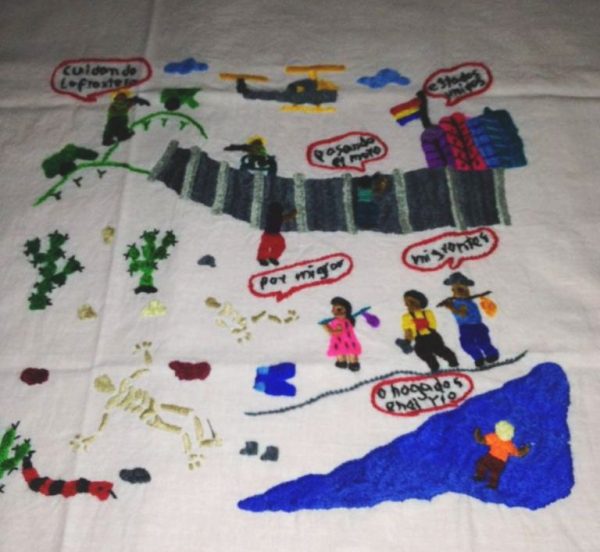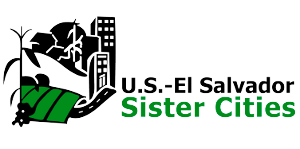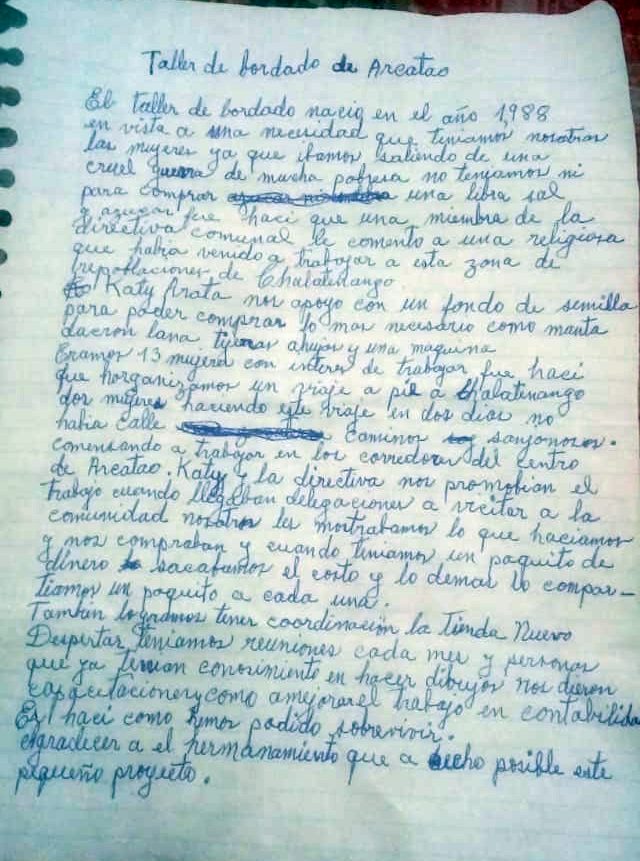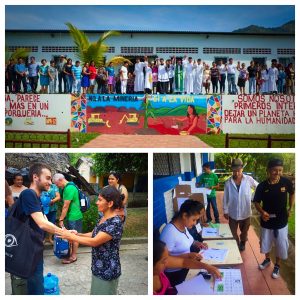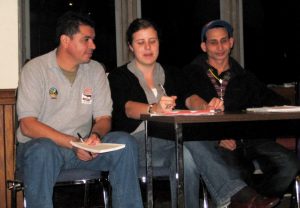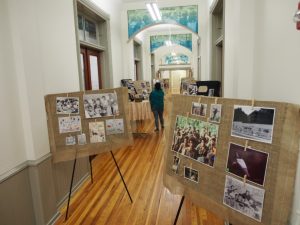Community Development Projects, Historical Memory, News from Communities, Online Resources
Embroidery in Arcatao / Bordados en Arcatao
(EN ESPAÑOL ABAJO)
A founding member of the embroidery cooperative of Arcatao shared how their work started:
The embroidery workshop was born in 1988, in view of a need that we women had, as we were emerging from a cruel war, of much poverty. We didn’t even have to buy a pound (of) salt and sugar. Thus, a member of the community board talked with a nun who had come to work in this repopulated area of Chalatenango.
Katy Arata supported us with a seed fund to buy the most necessary items such as blanket, dacron, wool, scissors, needles and a machine.
We were 13 women interested in working. That was how we organized a walking trip to Chalatenango. Two women doing this trip in two days. There was no street, only ditch roads.
We started to work in the corridors of the center of Arcatao. Katy and the board promoted our work when delegations arrived to visit the community. We showed them what we did and they bought it from us. When we had a little money, we took out the cost and the rest, we shared among each other.
We also managed to coordinate with the “New Awakening” store. We had meetings every month and people who already had knowledge in making drawings, gave us training on how to improve our accounting.
This is how we have been able to survive.
We thank the sistered committee that has made this small project possible.
Sister Cities’ national (and board) member Dr. Molly Todd adds the following:
The impact of the embroidery experience in Mesa Grande has been tremendous for many women. In historic memory workshops in Cuscatlan, for example, we had a whole discussion about how learning embroidery as a refugee helped to pass the time, helped make them feel useful even in the midst of the isolating experience of the camps, and, once back in El Salvador, offered them a means of making money. Several women talked about continuing to embroider on their own and selling their pieces to the church, bakery, and other outlets. This individualized work is, of course, very different than the collective effort in Arcatao, but it illustrates the varied long term impacts that one experience in the camps can have.
From memory, I can tell you that the cooperative nature of embroidering (as we understand/see it today) did begin in Mesa Grande in the mid-1980s. Like the other communal workshops (hammocks, shoes, sewing, metalwork, etc.), the embroidery group contributed to the everyday life in the camps through their labor. They were among the important “PR” groups because their work was often given to visitors to the camps. Many of the early embroideries were pictorial messages, carrying condemnation of the war, calls for solidarity, protests against forced relocation, etc. These messages were then carried off by the internacionalistas, to spread the word and support the refugees’ efforts.
What is interesting about these migration embroideries coming out of Arcatao is that they are a direct result of Madison’s request to the cooperativistas to prepare some embroideries that reflected their perspectives on/understanding of migration today. I can look back in my records, but it was roughly 5 or 8 years ago (I remember carrying the request down there and then, later, bringing the finished bordados back to Madison). At the same time, they asked for some bordados that reflected the theme of education. These were a bit different than what the women had been doing for more than a decade — they’d moved away from the pictorial messages and more toward straight “pictures.” I remember them asking “but what do you want us to put on the migration embroidery?” And we kept saying that it was for them to decide what to put on there, based on their own personal and family and national experiences with migration in/out of the country.
Joan Laurion, from the Madison-Arcatao Sister Cities Project, adds:
We asked the women in the cooperativa for a piece that was about anything in their lives and the education piece was the first. It came on white background and said ” Education es el derecho de todos y todas”. We framed that one and it sold very quickly so we asked for more of the same but the subsequent education pieces have not been quite as attractive — it’s hard without photos and templates to get the following pieces the same.
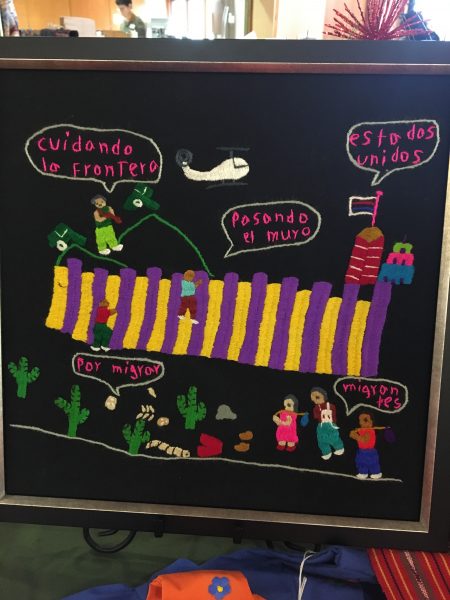
Molly is right that that piece was important to the women but was a set piece with a universal idea– like the world with people holding hands around it that is their signature piece. Then we asked for more about anything in their lives and on black fabric (like the Hmong story pieces we are familiar with here in Madison). The ones that came then were the arresting and beautiful pieces about anti mining and migration.
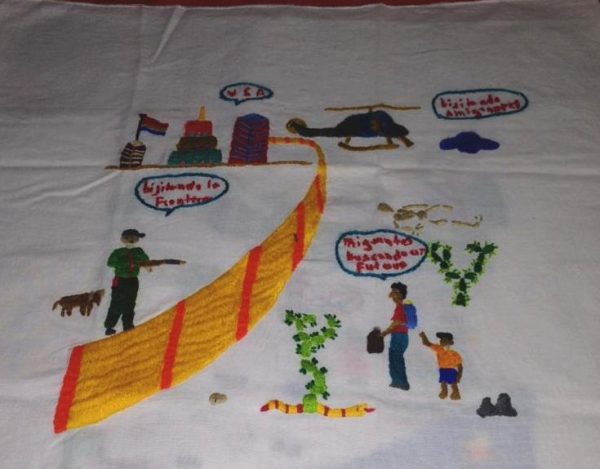
Una de las fundadoras del taller de bordado en Arcatao nos comparte los inicios de su trabajo colectivo:
El taller de bordado nació en el año 1988, en vista de una necesidad que teníamos nosotras las mujeres, ya que íbamos saliendo de una cruel guerra, de mucha pobreza. No teníamos ni para comprar una libra (de) sal y azúcar. Fue así que una miembra de la directiva comunal le comentó a una religiosa que había venido a trabajar a esta zona de repoblaciones de Chalatenango.
Katy Arata nos apoyó con un fondo de semilla para poder comprar lo más necesitario como manta, dacrón, lana, tijeras, agujas y una máquina.
Éramos 13 mujeres con interés de trabajar. Fue así que organizamos un viaje a pie a Chalatenango. Dos mujeres haciendo este viaje en dos días. No había calle, (solo) caminos zanjonosos.
(Comenzamos) a trabajar en los corredores del centro de Arcatao. Katy y la directiva nos promovían el trabajo cuando llegaban delegaciones a visitar a la comunidad. Nosotras les mostrábamos lo que hacíamos y nos compraban. Cuando teníamos un poquito de dinero, sacábamos el costo y lo demás, lo compartíamos un poquito a cada una.
También logramos tener coordinación (con) la tienda Nuevo Despertar. Teníamos reuniones cada mes y personas que ya tenían conocimiento en hacer dibujos, nos dieron capacitaciones como mejorar el trabajo en contabilidad.
Es así como hemos podido sobrevivir.
(Agradecemos) al hermanamiento que ha hecho posible este pequeño proyecto.
La dra. Molly Todd, integrante de la junta de Ciudades Hermanas agrega lo siguiente:
El impacto de la experiencia del bordado en Mesa Grande ha sido tremendo para muchas mujeres. En talleres de memoria histórica en Cuscatlán, por ejemplo, tuvimos una gran discusión sobre cómo aprender a bordar ayudó a las personas refugiadas a pasar el tiempo, a que se sintieran útiles incluso en medio de la experiencia de aislamiento de los campamentos y, una vez de vuelta en El Salvador, les ofreció una forma de ganar dinero. Varias mujeres hablaron sobre continuar bordando por su cuenta y vendiendo su trabajo en la iglesia, panadería y otros lugares. Este trabajo individual es, por supuesto, muy diferente al esfuerzo colectivo en Arcatao; pero ilustra el diverso impacto a largo plazo que una experiencia en los campamentos puede tener.
Según recuerdo, la naturaleza cooperativa del bordado (tal como lo entendemos / vemos hoy) comenzó en Mesa Grande a mediados de la década de 1980. Al igual que los otros talleres comunitarios (hamacas, zapatos, costura, trabajos en metal, etc.), el grupo de bordados contribuyó a la vida cotidiana en los campamentos a través de su trabajo. Se encontraban entre los grupos importantes de “relaciones públicas” porque su trabajo a menudo se entregaba a los visitantes de los campamentos. Muchos de los primeros bordados fueron mensajes pictóricos, condenando la guerra, llamando a la solidaridad, protestas contra la reubicación forzada, etc. Estos mensajes fueron llevados por los internacionalistas, para difundir el mensaje y apoyar los esfuerzos de los refugiados.
Lo interesante de estos bordados de migración que salen de Arcatao es que son el resultado directo de una solicitud de Madison a las cooperativistas de preparar algunos bordados que reflejen sus perspectivas / comprensión de la migración actual. Puedo revisar mis registros, pero fue hace aproximadamente 5 u 8 años (recuerdo haber llevado la solicitud allí y luego, más tarde, llevar los bordados terminados a Madison). Al mismo tiempo, pidieron algunos bordados que reflejaran el tema de la educación. Estos fueron un poco diferentes a lo que las mujeres habían estado haciendo durante más de una década. Habían pasado de los mensajes pictóricos, más hacia las “imágenes”. Recuerdo que preguntaron “pero ¿qué quieres que le pongamos al bordado de migración?” Y les repetíamos que ellas tenían que decir qué poner, basándose en experiencias personales, familiares y nacionales con la migración dentro y fuera del país.
Joan Laurion, del comité de Madison, añade:
Les pedimos a las mujeres de la cooperativa una pieza que fuera de cualquier cosa en sus vidas y la de educación fue la primera. Tenía fondo blanco y decía “Educación es el derecho de todos y todas”. Enmarcamos ese y se vendió muy rápido, por lo que pedimos más de lo mismo; pero las piezas educativas posteriores no han sido tan atractivas: es difícil sin fotos y plantillas obtener el mismo diseño.
Molly tiene razón en que esa pieza era importante para las mujeres, pero era una pieza establecida con una idea universal, como el mundo rodeado de personas agarradas de la mano, que es su pieza distintiva. Luego pedimos más sobre cualquier cosa en sus vidas y en tela negra (como las piezas de la historia Hmong con las que estamos familiarizados aquí en Madison). Los que vinieron en ese momento fueron las bellas y deslumbrantes piezas sobre la lucha contra la minería y la migración.
